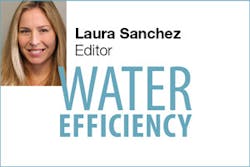I’m continually amazed by the way data allows us to “see” things that are otherwise invisible to the human eye—the exploration of cosmic landscapes that no human has ever traveled to, the molecular wonder of microscopic worlds, and recently the unseen places along the US coast where freshwater and seawater intermingle underground.
Using data collected by NASA’s Jet Propulsion Laboratory, Audrey Sawyer, assistant professor of earth sciences at Ohio State University, and a team of researchers, recently created a map of these invisible water exchanges. Pinpointing these sites of submarine groundwater discharge is of critical importance. For, as Sawyer explains, each one represents a point of vulnerability for water contamination.
“We’re all pretty familiar with the idea that rain falls on land and flows out to the ocean in rivers, but there’s another, hidden component of rainfall that infiltrates the ground near the coast and spills into the ocean below sea level,” Sawyer told The Ohio State University. “If you’ve ever been swimming in the ocean and felt a cold spot, there’s a good chance that the cold spot is due to groundwater seeping out from underfoot.”
She explains that there are two directions of potential contamination: sea to land and land to sea. “Freshwater flows out to sea, and vice versa. Urbanization, agricultural development, climate, and topography all affect how much water flows in either direction, and the exchange has a big impact on both onshore groundwater that we drink and offshore seawater where we swim and fish.”
Sawyer and the Jet Propulsion Laboratory’s Cedric David and James Famiglietti, examined rainfall, evaporation rates, and the amount of known surface runoff to calculate the amount of water flowing below ground. The study found that more than 15 billion tons of freshwater flow through these underground networks every year.
The team’s research determined that 12 percent of the continental US coastline is highly susceptible to freshwater contamination from septic tanks and fertilizer runoff. It also discovered that 9 percent of the US coastline is especially susceptible to contamination from sea to land.
Awareness of these hidden confluences means that we can now take more enlightened steps to protect our water resources from coastal contamination. The research team is currently collecting global data with the hope of creating a similar worldwide coastline study. What steps do you suggest that industry leaders and policy makers take once the areas of vulnerability are identified?
